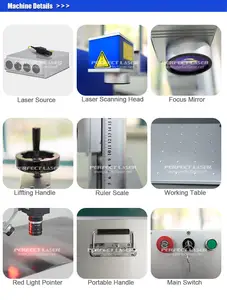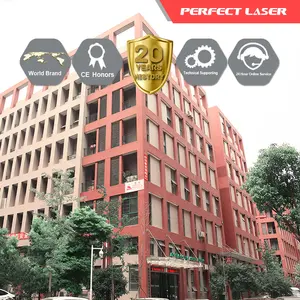
All categories
Featured selections
Trade Assurance
Buyer Central
Help Center
Get the app
Become a supplier

(210 products available)














































Laser marking machines have the capability to work on different materials, including metals, plastics, wood, and glass. They are also known for their precision and adaptability. The various types are as follows:
Fiber Laser Marking Machine
This one is a high-precision industrial-grade laser marking machine used on metals and alloys. These include aluminum, steel, copper, and other hard materials. The strong laser can make clear, deep markings. It is also durable and gives an excellent energy efficiency.
CO2 Laser Marking Machine
This kind of machine is good for non-metal materials. They include plastics, wood, and glass. This machine uses a gas-filled tube to make the laser. It is also an ideal option for companies that frequently work with organic materials.
Desktop Laser Marking Machine
This machine is small, making it ideal for quick jobs or small items. It is also a good option for businesses that need precise markings on small parts. Desktop machines work well for light materials like plastic, which makes them fit for small electronic parts or jewelry. Its small size makes the laser marking machine suitable for small workplaces.
Handheld Laser Marking Machine
Singapore's handheld laser marking machine is portable. Users can easily handle it, making it ideal for large or hard-to-reach items. It is suitable for outdoor use or for items that are not easy to move. This flexibility, however, comes at the cost of slight precision loss compared to fixed machines. It is great for large metal parts, so it fits manufacturing sites.
UV Laser Marking Machine
It is a good option for delicate materials. They include glass or PCBs. Its low-heat laser avoids damage to fragile items. It is also good for marking items that need clear, fine details. UV lasers help make good marks on sensitive materials. They include medical devices.
Laser marking machines have specific features that impact performance. Here are some of them:
Laser Types
There are laser types in laser marking machines. They include fiber, CO2, and UV lasers. Each type works best on certain materials. Fiber lasers work well on metals, while CO2 is better for organic materials. UV lasers are gentle enough for fragile items.
Marking Speed and Depth
Speed is important when working on a large number of items. Most machines can mark at speeds of 7 to 100 inches per minute. Depth is how deep the marking is done. Deeper markings give more detail but take more time. Users should select machines with fast speeds and adjustable depths for better efficiency.
Cooling Systems
Machines with good cooling systems last longer. They stop the parts from overheating during long work hours. Customers should search for machines with either air or water cooling to maintain a safe working level.
Focus Lens and Spot Size
Focus lenses shape lasers to mark materials correctly. The smaller the spot size, the more detailed the mark will be. Larger spots cut time but reduce detail. Select machines with different lenses to adjust for various tasks.
Safety Features
In any machine, safety should come first. Most machines in the market today have covers, sensors, and stop buttons to reduce risks.
Industrial Manufacturing
Companies in this industry rely on laser marking machines for many tasks. They need to make parts fast, so lasers help them mark items quickly and precisely. Lasers work well on metals and other materials used in machines and vehicles.
Electronics Labeling
The electronics industry also uses laser machines a lot. They help mark circuit boards, chips, and other small parts. Lasers make tiny, detailed labels that don't wear off. The precision makes electronics easy to track and identify.
Medical Device Identification
Medtech firms need clear, durable markings on their devices. Lasers are perfect for this since they can etch info right onto metal and plastic tools. The markings must stand up to heat, pressure, and sanitation.
Automotive Part Numbering
Car makers use laser marking machines to etch VINs, barcodes, and other IDs onto metal parts. It ensures each piece can be tracked throughout assembly and repairs. The marks must be very precise to comply with strict regulations.
Jewelry Maker Decoration
Laser machines are also valuable to jewelers. They use them to add intricate patterns, customer names, or tiny stones to pieces. The lasers allow for very fine detail that handwork can't achieve. Customers love personalized items marked with their initials or special designs.
Aerospace Component Tracking
The aerospace sector needs similar capabilities. Laser machines etch barcodes and other IDs onto complex engine and airplane parts. It's vital for maintenance tracking and ensuring safety. The technology ensures fast, accurate marking even on small, detailed components.
It is important for business owners to go for a laser marking machine that will meet their customer's needs. Below are some of the key factors to consider:
Material
Business owners should first consider the type of materials their customers commonly use. A fiber laser marking machine works well for metal materials, such as stainless steel and aluminum. On the other hand, a co2 metal laser is ideal for plastic, glass, and wood. A UV laser machine is suitable for customers who will be working with delicate items. The reason behind this is that it does not generate heat.
Power
Marking machines normally come with different power settings. A powerful machine will easily handle deep engravings, especially on hard materials. A low-power machine, on the other hand, will be ideal for offering shallow engravings on soft materials. Business owners should go for a machine power that will suit their customer's common use.
Speed
In most cases, the speed of a marking machine is usually indicated in the form of inches per minute. Therefore, if business owners are planning to sell laser engraving machines that will suit bulk marking, they should ensure that the machine has a high speed. On the other hand, low-speed machines are suitable for businesses that will require a lot of precision.
Precision and accuracy
Most engraving machines come with a focus lens that enables the user to control the spot size. Generally, the smaller the spot size, the more accurate the engraving will be. That is why business owners should ensure that the machine they purchase has different focus lenses. This will enable their customers to adjust the spot size depending on the engraving project.
Software compatibility
Practically, most laser marking machines come with unique software. Therefore, before business owners purchase a laser marking machine, they should ensure that it is compatible with the common design software in the market. This is because customers will most likely use the design software they are used to.
Maintenance
In this case, customers will prefer machines that are easy to maintain. For instance, laser marking machines that come with a water-cooling system are easy to maintain compared to those with air-cooling systems. Also, business owners should ensure that the machines they purchase come with a maintenance guide. This will enable their customers to operate the machines without damaging them.
Mostly, laser marking machines are manufactured with protective enclosures that safeguard internal components from being damaged by environmental factors, such as dust and humidity. Some machines also have IP ratings. This rating is ideal for identifying the level of protection against specific environmental hazards. To avoid exposure to harsh weather conditions, laser marking machines are usually stored in indoor facilities or workrooms.
In most cases, plastic tends to respond well to heat. Therefore, when laser beams penetrate the plastic surface, they create a durable mark without actually damaging the material. For instance, deep cuts will generate a three-dimensional effect, while high-contrast markings will leave a heated area that appears charred or burnt.
Sometimes, the terms “laser engraving” and “laser marking” are used interchangeably. However, there is a slight difference between the two. Laser marking refers to the process of using laser technology to leave marks or impressions on a given surface. This impression can be a permanent change in color, a shallow indentation, or a deep carving. On the other hand, laser engraving is specifically aimed at carving out material to create deeper inscriptions or designs. In simple terms, all laser engravings are laser markings. However, not all laser markings are laser engravings.
Usually, the key to achieving the best results when working with various materials lies in understanding their unique properties. Materials such as metals require high-intensity laser beams to achieve efficient results. On the other hand, organic materials require gentle laser treatments to avoid causing them burns. Ideally, each material has specific requirements when being marked with laser beams. These requirements include laser power, speed, frequency, and pulse duration.